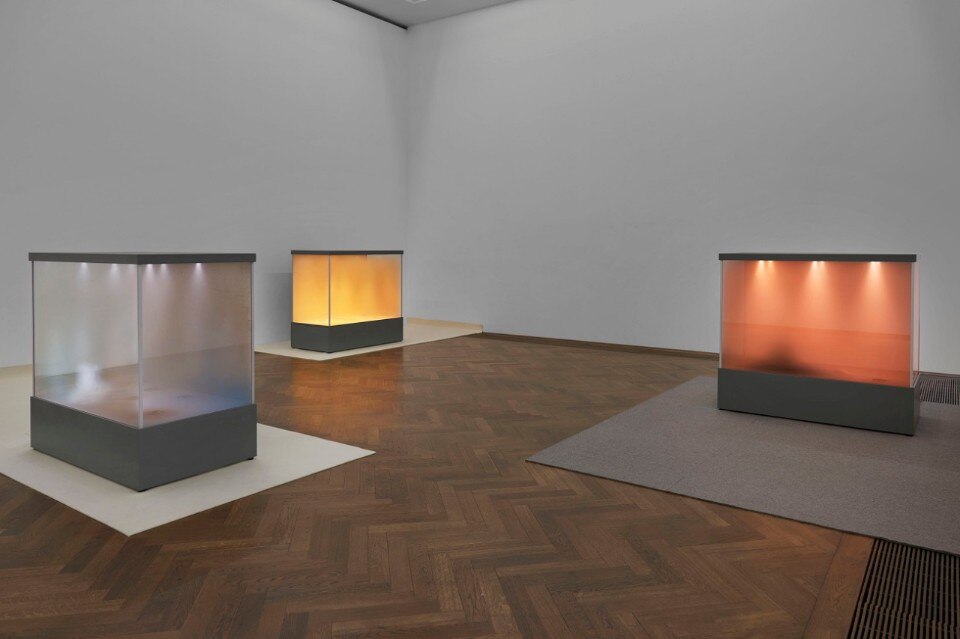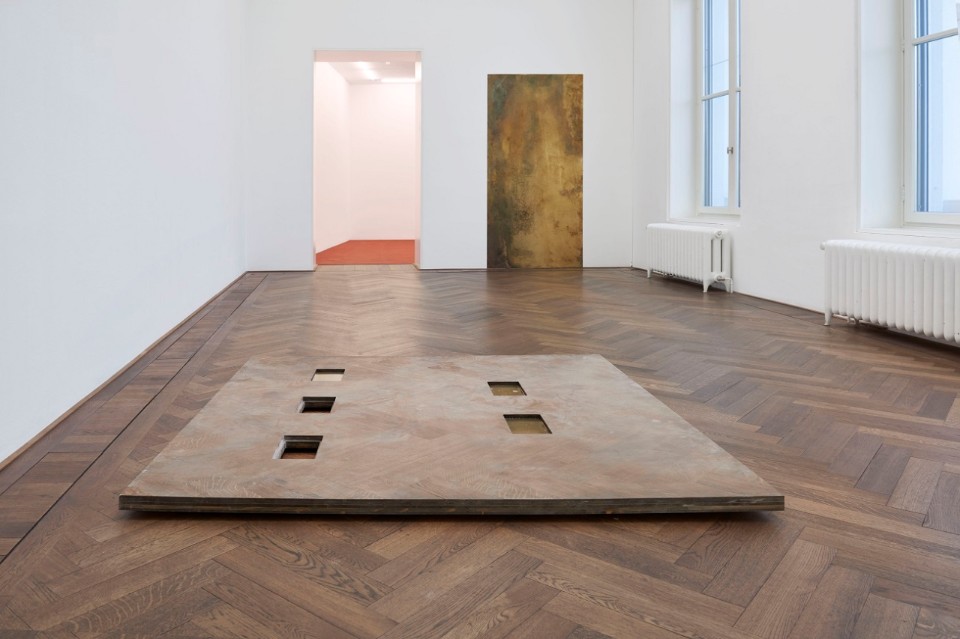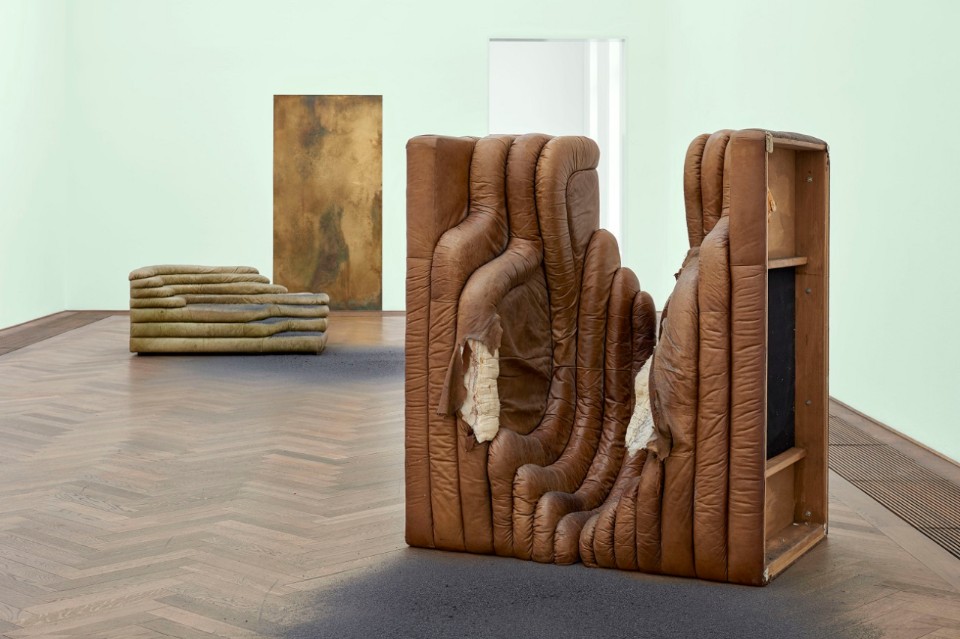Through huge structural installations, “I am Gong” introduced – during Art Basel – the oeuvre by Dora Budor (b. 1984), the Croatian, New York-based artist. Structuring transparent systems she created a net of references that, only on the ground-floor, spreads through all five Kunsthalle’s rooms.
The first long corridor is voted to welcome to the visitors through a scattered archipelago composed by: Solo for 1872 (2019); Solo for 1973 (2019); Solo for 1876 (2019); while four vintage sofas (DS-1025, from the 1970s) by De Sede compose The Year without a Summer (Klug’s Field, 2019), where piles of ash are accumulated on the floor and on the flipped-over sofas, on their leather trimmings.
Those pieces were made as a counter-reformation to Modernist furniture, transgressing its rigid language. Each has a unique life cycle and has been exhausted through a different series of events. The falling ash mirrors such a cycle of time. The exhibition opens with such installation in order to create a desolate environment enveloped in a slightly greenish light.
Worn leather sofas, some battered and torn, occupy the space, their modular, 1970s utopian designs serving as the landscape’s ground. Overhead, four machines each sporadically release flutters of cinematic special-effect ash according to furtive rules. Piles of look-a-like cinders accumulate on the floor and sofas as if in the aftermath of some unidentified cataclysm. In fact, the speed and quantity of the ash falls, and thus the sizes and shapes of the piles, each visibly manifest the noise level transmitted from a different area of the Musiksaal.
Three large brass plates also occupy the space. Specially treated to display the patina and marks of age that would allow their being assigned to different historical moments, each is a representation of time’s passage. A fourth such plate, in the second room, joins an architectural mock-up of the planned parquet flooring for the Musiksaal. Here the archeological process merges with the a vestigial, endemic research of unpredictable external force traces.
Empty cavities belong to Kunsthalle Basel as if they were leftovers, fragments of its 2004 modernization. Visible and invisible structures hide closed-off spaces and gutted hollows in the walls, ceilings, and floors. These are inhabited by The Sound-Sweep [2019], a modulating soundscape that emerges from the building. It’s directed by Tuning (Well, It’s a Vertebrate...) [2019], the recording device Dora Budor installed inside the Musiksaal, which functions as a resonating yet invisible umbilical cord between that building and Kunsthalle Basel.
It transmits construction noises – drilling, arguments, and continuous rattling, turning them into an abstract heartbeat, or a pulsation, that in turn activates parts of the installation in the Kunsthalle. It acts as invasive species on the space, or what Pierre Schaeffer and Jérome Peignot term the acousmatique; whereby sounds that are experienced separately from their causes produce a new paradigm of dislocation. Low levels of sound are left in solid surfaces and slowly trickle out of them over time, giving the inhabitants emotional flashbacks, disease and trauma.
There is another, even more prescient sense of the world becoming an objet sonore, the emergence of an increasingly synthetic acoustic realm also marks the most sophisticated form of social control. Because the Musiksaal will be undergoing renovation until 2020, all we can see is the facade, draped in construction sheets. The dysfunctional concert hall remains a fiction of sorts, but it’s coming into being serves as a motor for the exhibition.

Basel’s Musiksaal, a legendary concert hall located across the street, is the show’s meaningful trait d’union, among several different sculptural groups. Designed by Johann Jakob Stehlin-Burckhardt and completed in 1876 (four years after its neighbor, Kunsthalle Basel, which he also designed) represent a fictional and metaphorical, but also an acoustic counterpart, to a Kunsthalle dedicated to the visual arts. T
he Musiksaal’s current, almost archaeological reconstruction governs the formal, atmospheric, and sonic conditions of Budor’s exhibition. Sound-sensitive devices placed inside the construction site collect signals–shrill noises of construction drills, metal beams being welded, wind whipping past the windows and transmit their frequencies in real time to Kunsthalle Basel, if, when, and with whatever intensity they occur.
The three vitrines of Origin I (A Stag Drinking) [2019], Origin II (Burning of the Houses) [2019], and Origin III (Snow Storm) [2019] appear as three monochromatic and dusty terrarium assembled by: three custom environmental chambers (reactive electronic system, compressor, valves, 3D printed elements, aluminium, acrylic, LED light, glass, wood, paint), puffing organic and synthetic pigments, diatomaceous earth, FX dust and felt. The technology applied is the same one studied for environmental test chambers, used in factories to test and accelerate the effects of time and weather on manufactured objects.

They show eruptions of pigments and soils, creating ephemeral, atmospheric scenarios that evolve throughout the time of the exhibition as piles of residue accumulate. Their colors are related to Dora Budor’s practice, like glimpses of past weather, they tell us about volcanic and industrial particles in the air, and dust in the atmosphere, at a time that correlates with when Kunsthalle Basel was built.
The artist is interested in Turner’s studio practice. In his book Weather Architecture, Jonathan Hill describes how Turner’s visitors were shocked to discover that he would put some of his unfinished paintings in the back room of his damp and unheated studio, where rain and snow could fall through the broken skylight.
They thought he had gone mad, while he just was letting the actual weather conditions find their way into the images, rendering not only representations of this historical time, but unique markers of time and space. Bu the most impressive installation, at Kunsthalle is the yellow version of the so-called The Preserving Machine, 2018–19. A three-meters long, transparent, bloated bulkhead realized with a biomimetic robot bird, tinted vinyl enclosure, custom audio-to-motion computer navigation system, detritus, parts of building remains from the construction site of the Musiksaal (elements from 1886, 1905, and 1930), including also an architectural mock-up facade from the Musiksaal.
- Exhibition Title:
- Dora Budor. I am Gong
- Opening dates:
- Fom May 24 2019 to August 11 2019
- Curated by:
- Elena Filipovic
- Venue:
- Kunsthalle Basel
- Address:
- Steinenberg 7, CH-4051 Basel


